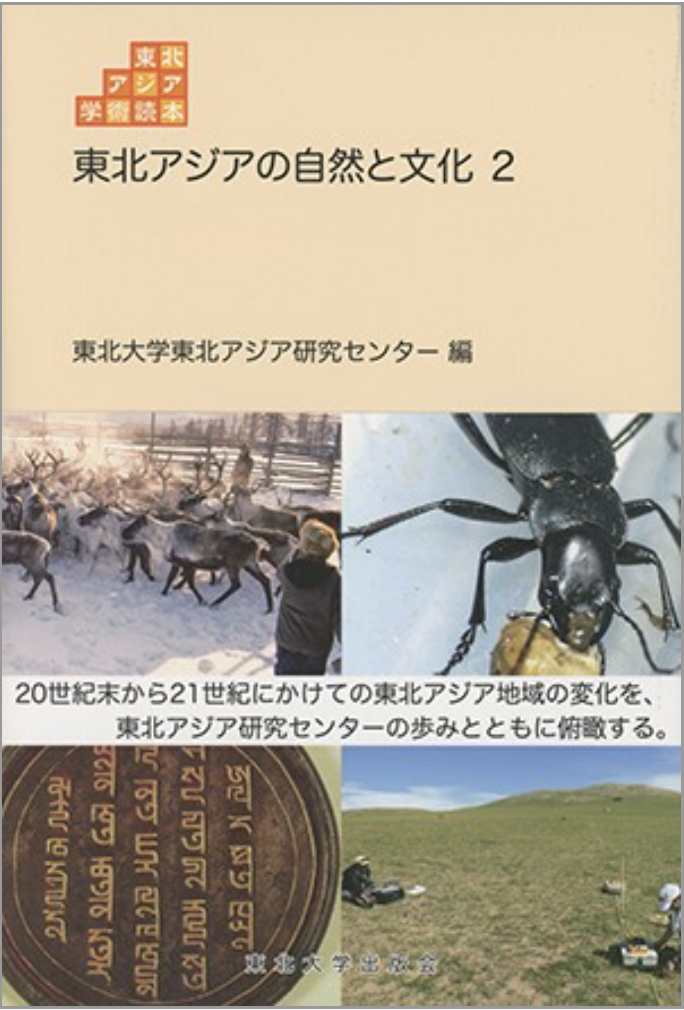
Katsuhiro SANO, Akio GOTO, eds.
This book is a sequel of the CNEAS Book 7 “Nature and Culture in the Northeast Asia” published in March 2018, comprising selected articles from Newsletter “Ushitora” by The Association for Northeast Asian Studies. The fruitful articles reflect activities by members of the association for over 20 years and provide us an overview on diverse studies in Northeast Asian.

Aratake Kenichiro, Takahashi Yohichi, eds.
The safeguarding of historical resources has become an increasingly important task amid the challenges of today. These challenges include social issues such as the falling birthrate, the graying population, and depopulation. They also include the threat of natural disasters across Japan. Measures to safeguard local historical heritage have been undertaken by specialist researchers as well as by other actors such as archive owners, local residents, and local governments. In this paper, I trace the safeguarding efforts undertaken in Japan’s Tohoku region and discuss ways to shift from safeguarding to using local historical resources. This research reveals lessons from history in relation to the following focal themes: inheritance from predecessors and the psychology of archive owners, the struggles of local government employees, and the renewed efforts of people who strive to communicate research outcomes to the public.

Masachika SHIOTANI and Akio GOTO
Center for Northeast Asian studies celebrated the anniversary of 20 years in 2015. This book was planned as one of projects for the20th anniversary of the Center. The Book was edited from the past articles of “News Letter” and “Ushitora”. If you read each article, you can understand how the region of Northeast Asia changed in 20 years.

Motoyuki SATO, Akihiro KANEDA, Kazunori TAKAHASHI eds.

IRUMADA Nobuo, NAKANO Yoshifumi, ARATAKE Kenichiro
This book is a text which can be studied in detail focusing on a World Cultural Heritage of Japan. Japan concluded "Convention Concerning the Protection of the World Cultural and Natural Heritage" in 1992, and registration of much world heritage is performed. In various parts of Japan, movement which aimed at registration still now is carried out. Why is world heritage important? Moreover, what kind of meaning does being registered have? This book presents world heritage for Hiraizumi, Iwami, Nikko, etc. to a model case intelligibly.

TAKAKURA Hiroki, YAMAGUCHI Mikako eds.
This book is based on the symposium organized at Sendai in November 2012. Researchers who has traveled in Siberia, North America, and South America, shows the structure of the society for obtaining food, and the ritual that relate to their view of the world and religion. They revealed how to extend cultural diversity in the world based not only on modern world but on archaeological and indigenous viewpoints. It is an alternative method for understanding the world.

OKUMURA Makoto, FUJIWARA Junko, UEDA Kyoko, KAMIYA Daisuke
In Northeast Asia region, transportation is sometimes suspended by severe natural climate and disasters. This book introduces how human and society prepare and react against transportation suspensions and regional isolations, in several communities in a village of Arctic Siberia after the collapse of Soviet Union facing to the Global climate change, remote islands of Okinawa vulnerable to typhoon storms and high waves, and Sendai at the time of the Great East Japan Earthquake. By a variety of methods anthropological field research, sociological participating observation, consideration from Infrastructure Planning viewpoint, and microeconomic analysis, researchers have revealed the multiple faces of transportation suspension and regional isolation.

ISHIWATARI Akira and ISOZAKI Yukio
Geological linkage between Japanese Islands and Korean Peninsula, Chinese Continent, and continental margin of Far East Russia is explained from global viewpoints using many maps and diagrams. Geological topics such as crust-mantle structure of the earth, history of continental drift and formation of the Japan Sea are also described with episodes of the field work. This is an account of the lectures of the same title that were given by the authors at Sendai in 2009.

TAKAKURA Hiroki and SOGA Toru
This is the handbook for the anthropology of the pastoral nomads. How human survive the harsh environment of Siberia and Africa, which is the core question of this book, describing the charm of the tradition of Eveny and Gabura peoples. Given the overall pictures in Siberia and Africa, the mechanism of technological and social livelihood of people living with reindeer and camels as livestock are ethnographically explained. They are the indigenous ethnic minorities in their countries, which lives are at the forefront of the contradictions of modern state and development such as ethnic conflicts, refugee problems, and market economy. Authors focus on these predicaments but also uncover their hopes for future.